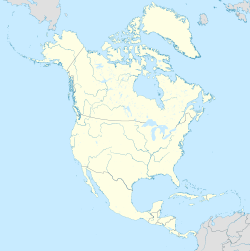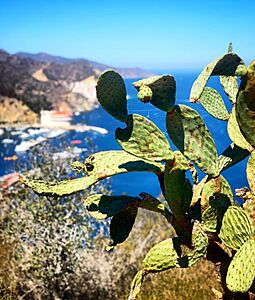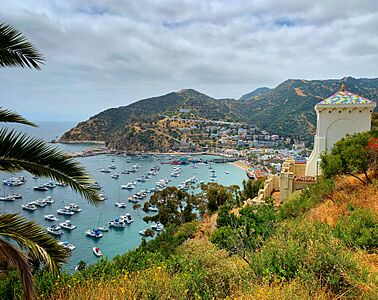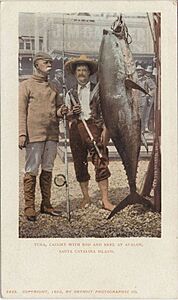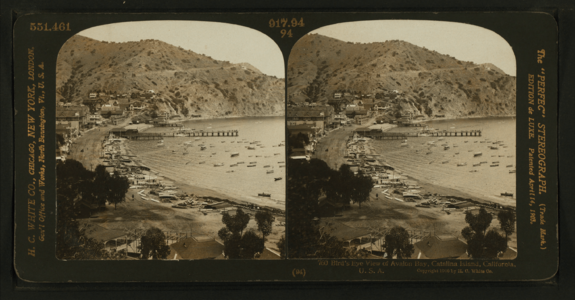Avalon, California facts for kids
Quick facts for kids
Avalon, California
|
|||
|---|---|---|---|

Avalon Harbor
|
|||
|
|||
| Motto(s):
To the Island Valley of Avalon
|
|||
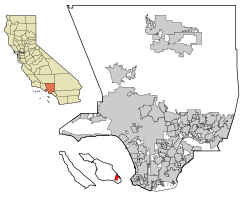
Location of Avalon in Los Angeles County, California
|
|||
| Country | |||
| State | |||
| County | Los Angeles | ||
| Incorporated (city) | June 26, 1913 | ||
| Named for | Avalon island, Idylls of the King | ||
| Government | |||
| • Type | Council–manager | ||
| Area | |||
| • Total | 7.66 sq mi (19.83 km2) | ||
| • Land | 2.89 sq mi (7.47 km2) | ||
| • Water | 4.77 sq mi (12.35 km2) 0.07% | ||
| Elevation | 30 ft (9 m) | ||
| Population
(2020)
|
|||
| • Total | 3,460 | ||
| • Density | 1,198.89/sq mi (462.94/km2) | ||
| Time zone | UTC-8 (PST) | ||
| • Summer (DST) | UTC-7 (PDT) | ||
| ZIP Code |
90704
|
||
| Area code(s) | 310/424 | ||
| FIPS code | 06-03274 | ||
| GNIS feature ID | 1660283 | ||
| Website | http://cityofavalon.com/ | ||
Avalon is the only city on Santa Catalina Island. This island is part of the California Channel Islands. Avalon is also the southernmost city in Los Angeles County.
It's a popular resort community. Many businesses along the waterfront are focused on tourism. The older parts of town have small houses and buildings in traditional styles.
In 1919, William Wrigley Jr., who made chewing gum, took control of Avalon. He helped build many parts of the city, including the famous Catalina Casino. Before Wrigley, several people tried to make Avalon a resort. But most of them went bankrupt.
In 2020, about 3,460 people lived in Avalon. Around 1 million visitors come to Avalon each year. Cruise ships often stop here too. Before Europeans arrived, the Tongva people lived on the island.
Contents
History of Avalon
Before modern times, the Gabrielino/Tongva tribe lived in Avalon Bay. The island was a key place for them to get soapstone. They used this stone to make cooking pots. The Tongva called the island Pimu or Pimugna. They called themselves the Pimugnans. By the 1830s, the native people had either died or were moved to the mainland. They worked in missions or on ranches.
In the 1860s, Augustus William Timms ran a sheep farm on Catalina Island. His boat, the Rosita, also took people to Avalon Bay for fun. They went swimming and fishing. The settlement was then called Timms's Landing. By 1883, there were thirty tents and three wooden buildings there.
Early Resort Development
The first person to try to make Avalon Bay a resort was George Shatto. He was a real estate investor from Michigan. Shatto bought the island for $200,000 in 1887. This was during a big real estate boom in Southern California.
Shatto created the town that became Avalon. He built the town's first hotel, the original Hotel Metropole, and a pier. Early maps called the town Shatto. But Shatto's sister-in-law, Etta Whitney, named it Avalon. This name came from a poem by Lord Tennyson called "Idylls of the King". The poem is about King Arthur and features an island of the same name. Shatto planned Avalon's streets. He also made it a popular vacation spot. However, after a few years, he couldn't pay his loan. The island went back to the Lick estate.
The sons of Phineas Banning bought the island in 1891. They started the Santa Catalina Island Company. Their goal was to make it a resort. The Banning brothers made Shatto's dream come true. They built a dance hall in the town center. They added to the Hotel Metropole and the steamer-wharf. They also built an aquarium and a men-only gambling club called the Pilgrim Club.
Just as the Bannings planned a new hotel, the Hotel Saint Catherine, a fire hit. On November 29, 1915, a fire burned half of Avalon's buildings. This included six hotels and several clubs. In 1919, because of fire debt and less tourism during World War I, the Bannings had to sell parts of the island.
Wrigley's Influence on Avalon
In February 1919, William Wrigley, Jr., the chewing gum maker, bought most of Santa Catalina Island. Wrigley wanted to protect and improve the island. He spent millions on important buildings and attractions. This included building the new Catalina Casino, which opened on May 29, 1929.
To help Avalon grow, Wrigley bought more steamships. These included the SS Virginia (renamed the SS Avalon) and the SS Catalina. The SS Catalina started service on May 3, 1924. Wrigley also made Avalon famous by having his Chicago Cubs baseball team train there. They used the island for spring training from 1921 to 1951. The baseball field was near Avalon, between Tremont Street and the golf course.
After William Wrigley, Jr. died in 1932, his son Philip K. Wrigley took over the Santa Catalina Island Company. Philip continued to improve Avalon's buildings and services. During World War II, the island was closed to tourists. It was used for military training. The U.S. Maritime Service set up a training center in Avalon. Catalina's steamships were used to carry troops.
In 1975, Philip Wrigley gave his shares in the Santa Catalina Island Company to the Catalina Island Conservancy. He had helped create this group. The Conservancy now manages 88 percent of the island. This is mostly outside of Avalon. The Santa Catalina Island Company still owns and runs many tourist spots in Avalon. These include the Catalina Visitors Country Club, Catalina Island Golf Course, Descanso Beach Club, and the Casino Ballroom.
In May 2007, the Island Fire burned about 4,750 acres (19 km2) of land near Avalon. Over 200 firefighters came by U.S. Marine hovercraft and helicopter to protect the city. Only one house and six business buildings were destroyed.
In 2011, a report said Avalon had one of the most polluted beaches in the U.S. This was due to old sewer pipes. The city spent millions to fix the pipes. By 2014, the water quality had improved. Avalon Beach was removed from the polluted beaches list.
In the 2010s, the Santa Catalina Island Company started to update tourist areas. They added a zip line at Descanso Beach. They also worked on a spa, a new hotel, and new homes. A big project was a new $6-million museum building. Some people in the community worried about how fast these changes were happening.
Geography of Avalon
Avalon is on Santa Catalina Island. It is about 22 miles (35 km) south-southwest of the Los Angeles Harbor breakwater. It is the only city on one of the eight Channel Islands of California. Because it's on Catalina Island, it is the southernmost city in Los Angeles County. The city covers about 2.9 square miles (7.5 km2) of land.
City Layout
The city of Avalon is built around Avalon Bay. The harbor and beaches are the main center of activity. The Cabrillo Mole is at the south end of the harbor. It acts as a wall against waves and has docks for passenger boats. Many shops and businesses for visitors are along Crescent Street. This is a pedestrian mall behind the main beaches. The walkway has special pavers, fountains, palm trees, and a decorative seawall. These features were added when Philip K. Wrigley redesigned Avalon in 1934.
The green Pleasure Pier extends into the middle of the harbor. The north end of the harbor is dominated by the Catalina Casino. This building mixes Art Deco and Mediterranean Revival styles. It is Avalon's most famous landmark.
North of the Casino is Descanso Beach. This is a private beach and event area run by the Santa Catalina Island Company. At the very north end of town are the Hamilton Cove condominiums. This is a private community with mostly second homes. South of the bay is Lovers Cove dive park. This is a marine reserve popular with snorkelers and glass-bottom boat tours. Further south is Pebbly Beach, an industrial area. It has the Pebbly Beach Seaplane Base & Heliport and the Pebbly Beach Generating Station, which provides power to Avalon.
Most homes in Avalon are away from the beachfront. They are either in the flat areas further into the canyon or on the hillsides. Many city buildings are deeper in the canyon. These include City Hall, the fire station, the Catalina Island Medical Center, and Avalon Schools. The William Wrigley Jr. Summer Cottage, also called Mount Ada, is now a hotel. The Wrigley Memorial and Botanical Gardens are at the farthest end of town from the bay. The Memorial uses local Catalina Island building materials. This includes famous pottery and tile made on the island from 1927 to 1937.
Climate in Avalon
Avalon has a semi-arid climate. This means it's usually dry but not a desert. Temperatures are mild all year. From 1909 to 1988, weather records were kept at the Avalon Pleasure Pier. In January, average high temperatures are around 64.6°F (18.1°C). Average lows are about 49.3°F (9.6°C). In August, average highs are about 75.4°F (24.1°C). Average lows are around 64.1°F (17.8°C). The highest temperature ever recorded was 105.1°F (40.6°C) on July 6, 2018. The lowest was 29°F (-1.7°C) on January 2, 1973.
Avalon gets about 11.88 inches (30.2 cm) of rain each year. It rains on about 34 days. The wettest year was 1983 with 34.54 inches (87.7 cm) of rain. The driest year was 1953 with 4.10 inches (10.4 cm). The most rain in one month was 11.68 inches (29.7 cm) in May 1921. The most rain in 24 hours was 6.75 inches (17.1 cm) on October 22, 1941. Weather records are still kept at the Santa Catalina airport.
| Climate data for Avalon, California (Avalon Pleasure Pier) (1909–1988) | |||||||||||||
|---|---|---|---|---|---|---|---|---|---|---|---|---|---|
| Month | Jan | Feb | Mar | Apr | May | Jun | Jul | Aug | Sep | Oct | Nov | Dec | Year |
| Record high °F (°C) | 85 (29) |
87 (31) |
88 (31) |
90 (32) |
90 (32) |
91 (33) |
95 (35) |
92 (33) |
97 (36) |
95 (35) |
89 (32) |
85 (29) |
97 (36) |
| Mean daily maximum °F (°C) | 62.0 (16.7) |
62.7 (17.1) |
64.0 (17.8) |
65.4 (18.6) |
67.0 (19.4) |
69.0 (20.6) |
72.0 (22.2) |
73.3 (22.9) |
72.8 (22.7) |
70.9 (21.6) |
67.4 (19.7) |
63.4 (17.4) |
67.5 (19.7) |
| Mean daily minimum °F (°C) | 47.2 (8.4) |
48.1 (8.9) |
49.4 (9.7) |
51.5 (10.8) |
54.2 (12.3) |
57.0 (13.9) |
60.6 (15.9) |
61.7 (16.5) |
60.0 (15.6) |
56.7 (13.7) |
51.7 (10.9) |
48.4 (9.1) |
53.9 (12.2) |
| Record low °F (°C) | 29 (−2) |
32 (0) |
37 (3) |
37 (3) |
32 (0) |
38 (3) |
45 (7) |
45 (7) |
41 (5) |
39 (4) |
37 (3) |
30 (−1) |
29 (−2) |
| Average precipitation inches (mm) | 2.40 (61) |
2.78 (71) |
2.04 (52) |
0.97 (25) |
0.35 (8.9) |
0.04 (1.0) |
0.00 (0.00) |
0.06 (1.5) |
0.25 (6.4) |
0.46 (12) |
1.15 (29) |
2.23 (57) |
12.73 (323) |
| Source: http://www.wrcc.dri.edu | |||||||||||||
Population of Avalon
| Historical population | |||
|---|---|---|---|
| Census | Pop. | %± | |
| 1920 | 586 | — | |
| 1930 | 1,897 | 223.7% | |
| 1940 | 1,637 | −13.7% | |
| 1950 | 1,506 | −8.0% | |
| 1960 | 1,536 | 2.0% | |
| 1970 | 1,520 | −1.0% | |
| 1980 | 2,022 | 33.0% | |
| 1990 | 2,918 | 44.3% | |
| 2000 | 3,127 | 7.2% | |
| 2010 | 3,728 | 19.2% | |
| 2020 | 3,460 | −7.2% | |
| U.S. Decennial Census | |||
In 2020, Avalon had a population of 3,460 people. The city's population density was about 1,199 people per square mile (463 per km2).
Economy of Avalon
Avalon is a resort community. Its economy mainly relies on tourism. In 2016, most working people (38.4%) had jobs in arts, entertainment, recreation, hotels, and food services. Other jobs were in retail (13%) and real estate (7%). Other important jobs were in education, healthcare, construction, transportation, and other services.
In 2012, there were 202 businesses in Avalon. They paid out $90 million in wages each year. The Love Catalina Island Tourism Authority helps promote the island. They have a Visitor Center on the Green Pleasure Pier that is open almost every day.
Education in Avalon
There are two preschools in Avalon: Catalina Kid Ventures and Pre-School Learning for Avalon Youth (P.L.A.Y.). Kid Ventures gets money from the city, tuition, and donations. P.L.A.Y. is a cooperative preschool. It is located where the old Bird Park used to be.
For K-12 education, children go to Avalon School. This school is part of the Long Beach Unified School District. It has elementary, middle, and high school levels, all run by one principal. The campus has three buildings in the Mission Style. It also has a gym and many classrooms.
For high school sports, Avalon is part of the CIF Southern Section. The school mascot is the Lancer. Teams are called the "Avalon Lancers" or "Lancers". Home games are played in Avalon. Visiting teams must travel by boat to the island. The Lancers travel to the mainland for away games.
Children in Avalon also have another choice for elementary school. They can go to the private Avalon Christian School. After elementary school, these students attend Avalon Schools for junior high and high school. In 2014, the school district closed the Two Harbors Elementary School. It was a one-room school in Two Harbors. It closed because only two students were left.
Transportation in Avalon
Several fast passenger boats serve Avalon daily. These include the Catalina Express to San Pedro (Los Angeles), Long Beach, and Dana Point. The Catalina Flyer also provides daily service to Newport Beach in Orange County.
If you bring a private boat to Avalon Harbor, the Harbor Patrol will give you a mooring spot. These are given out first-come, first-served. Boaters can get to shore by tying their dinghies at a dinghy dock. Or they can take a ride on a private shoreboat.
Several helicopter companies fly to Avalon. Most land at the Pebbly Beach Heliport, south of Avalon Bay. Small planes can land at the Catalina Airport, known as the "Airport in the Sky". It is about 7 miles (11 km) northwest of Avalon. In the 1970s, seaplanes used to fly from Avalon Harbor to Long Beach Airport and Orange County Airport.
The main way to get around Avalon is by small gas or electric cars. These are called "autoettes" by locals. They include many golf carts and similar small vehicles. Vehicles that are less than 55 inches (140 cm) wide, 120 inches (300 cm) long, and weigh less than 1,800 pounds (816 kg) can be autoettes. Each household can get one autoette permit. It is very hard for a private citizen to get a permit for a full-size car in Avalon. The permit is for the person, not a specific car. It must be given back if you stop living on the island. You cannot transfer it unless the city council approves. Only one new car permit is given for every two that are not renewed or given back.
For vehicle registration, Catalina Island has two areas: Avalon and "Interior" (outside city limits). Avalon has its own strict permit program. Car owners must follow these rules, plus the usual ones from the California Department of Motor Vehicles. Because of these rules, there is no regular car ferry service for visitors to bring their cars to Avalon or the rest of Catalina Island. A taxi service is available for transport in Avalon and around the island.
Images for kids
-
Two examples of "autoettes" in Avalon, a Mini and a golf cart
Gallery
See also
 In Spanish: Avalon (California) para niños
In Spanish: Avalon (California) para niños







